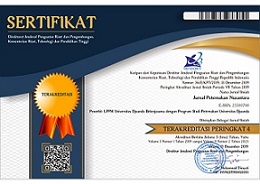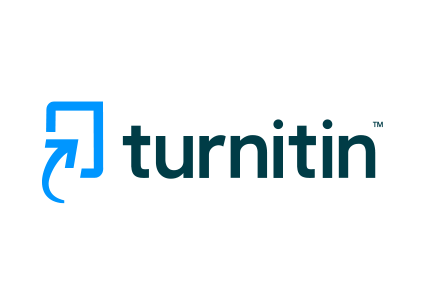THE EFFICACY OF PAPAYA LEAF EXTRACT INCLUSION IN DRINKING WATER AS AN IMPROVING OF LAYER QUAIL PRODUCTION
DOI:
https://doi.org/10.30997/jpnu.v3i1.855Abstract
Bacterial resistance to antibiotic has made the reduction in the use of antibiotic a concern in animal production. The restriction of antibiotic application in animal production can be achieved if the antimicrobial strategy is available. Papaya leaf extract has some antibacterial properties that make it is potential to be used as a substitute for commercial antibiotic. This study was aimed at assessing the efficacy and potential of papaya leaf extract inclusion in drinking water in controlling pathogenic bacteria and improving the production efficiency and feed conversion ratio (FCR) of layer quails. The study was conducted from 24 August to 20 September 2016 at the poultry farm of Department of Animal Husbandry, Djuanda University, Bogor. One-hundred layer quails were allocated into 4 treatments and 3 replicates in a completely randomized design. The treatments consisted of five levels of papaya leaf extract inclusions in drinking water , namely drinking water + commercial antibiotic of 0.5 g/liter water (R1), drinking water + papaya leaf extract of 10 ml/liter water (R2), drinking water + papaya leaf extract of 20 ml/liter water (R3), and drinking water + papaya leaf extract of 30 ml/liter water (R4). Data were subjected to an analysis of variance and a Duncan test. Results showed that the inclusion of papaya leaf extract in drinking water gave significant effects on egg mass, egg production efficiency, FCR, egg quality index, and egg shell thickness but not on feed intake, egg weight, and mortality rate. It was concluded that papaya leaf extract produced by a boiling method could be used as a substitute for synthetic antibiotic.
Key words: Papaya leaf extract, production efficiency, feed conversion, layer quail.
Downloads
References
Amrullah IK. 2003. Nutrisi Ayam Petelur. Cetakan 1. Satu Gunungbudi. Bogor.
Anggorodi, R. 1985. Kemajuan Mutakhir dalam Ilmu Makanan Ternak Unggas. Universitas Indonesia. Jakarta.
C.N, Sudjatinah, Wibowo Dan P. Widiyaningrum. 2005. Pengaruh Pemberian Ekstrak Daun Pepaya Terhadap Tampilan Produksi Ayam Broiler. J./Ndon. Trop.Anim.Agric. 30 (4) December 2005
Deptan, 2016. “ Pedoman Penataan Budidaya Puyuh”. http//www deptan.go.id diakses pada 5 desember 2016 (internet)
Ensminger, M. E, J.E Oldfield and W.W. Heinemann. 1990. Feed and Nutrition. Ensminger Publishing Company. California.
Ensminger M. A. 1992. Poultry Science (Animal Agriculture Series). 3rd Edition. Interstate Publishers, Inc. Danville, Illinois.
Gopperss. Smith JL. Goff JL. 2009. Advanced Nutrition and Human Metabolish. Fifth edition Wadsworth cengage learning, Belmont. USA. Hal 513-516.
Kalsum, U. H Sutanto, Achmanu and O. Sjofyan. 2012. Effect of a Probiotic Containing Lactobacillus on the Laying Performance and Egg Quality of Japanese Quals . Publish in Livestock Research for Rural Development
Kiha, A.F, W. Murningsih dan Tristiarti. 2012. Pengaruh Pemeraman Ransum dengan Sari Daun Pepaya terhadap Kecernaan Lemak dan Energi Metabolis Ayam Broiler. Animal Agricultural Journal, Vol. 1. No. 1, 2012, p 265 – 276 Online at : http://ejournal-s1.undip.ac.id/index.php/aaj
Listiyowati E, Roospitasari K. 2004. Puyuh Tata Laksana Budidaya Secara Komersial. Penebar Swadaya. Jakarta.
Luthfi M, Hanafi Nur, dan Anggraeni. 2015. Pengaruh Penambahan Larutan Ekstrak Kunyit dalam Air Minum terhadap Produksi Telur Burung Puyuh. Jurnal Peternakan Nusantara 2(2):159–166.
North M. O. dan Bell D. D. 1992. Commercial Chicken Production Manual. 4th Edition. An AVI Book Published by Van Nostrand Reinhold, New York
Nugroho E dan IGK Mayun. 1991. Beternak Puyuh. Eka Off Set, Semarang. Nutritional Reaserch Council. 1997.
Pangestuti, 2009. Analisis Kelayakan Usaha Peternakan Puyuh Pada Peternakan Puyuh Bintang Tiga Desa Situ Ilir, Kecamatan Cibungbulang, Kabupaten Bogor. [Skripsi]. Departemen Agribisnis akultas Ekonomi danManajemen Institut Pertanian Bogor. Bogor.
Prahasta arief, Masturi hasanawi. 2009. Agribisnis Burung Puyuh. CV Pustaka Grafika. Bandung..
Rahayu IHS. 2001. Karakteristik fisik dan nutrisi telur ayam Merawang. Seminar
Romanoff AL, Romanoff AJ. 1963. The Avian Egg. John Wiley and Son. Inc, New York.
Scott. M.L, Nesheim and R.J. Yaoung. 1992. Nutrition Of The Chicken M.L Scott and Associates, Ithaca New York.
Steell R.G.D dan J.H Torrie. 1993. Prinsip-Prinsip dan Prosedur Statistika. Edisi ke-2. MC Graw Hill Book Company. Inc. New York.
Sudaryani T. 2006. Kualitas Telur. Jakarta: Penebar Swadaya.
Sudrajat , Kardaya . 2004. Pengaruh Suplementasi Amonium Klorida dan Zinz Sulfat terhadap pH Plasma, Kadar Hb, Jumlah Leukosit dan Eritrosit Broiler pada Cuaca Panas, Majalah Ilmiah Angsana, Ikatan Alumni Fakultas Peternakan Jambi. 08(01):20:25.
Sudrajat D, Kardaya D, Dihansih E, Puteri SFS.2014. Performa produksi telur burung puyuh yang diberi ransum mengandung kromium organik. JITV 19(4): 257-262
Sudrajat , Kardaya dan Sahroji. 2015. Produksi telur puyuh yang diberi air minum larutan daun sirih. Jurnal Peternakan Nusantara 1(2): 159 – 166..
Sukardiman dan Wiwied E. Uji Anti Kanker dan Induksi Apoptosis Fraksi Kloroform dari Daun Papaya (Carica papaya,L.) terhadap Kultur Sel Kanker.
http://digilib.litbang.depkes.go.id/gophp?node=146 jkpkbppk-gdl-res-2007-sukardiman-2328
Sumbawati. 1992. Penggunaan beberapa tingkat zeolit dengan tingkat protein dalam ransum burung puyuh terhadap produksi telur, indeks putih telur dan indeks kuning telur. [Skripsi]. Fakultas Peternakan, Institut Pertanian Bogor, Bogor.
Suprijatna E.dkk. 2005. Ilmu Dasar Ternak UnggasPenebar Swadaya. Jakarta.
Suttle NF.2010. Mineral Nutrition of Livestock. 4 th Edition. CAB International, Wallingford. Hlm.453.
Tiwari KS, Panda B. 1978. Production and Quality Characteristics of Quail Egg. Indian J. Poultry Sci. 13 (1): 27-32
Widjastuti, Tuti. 2009. Pemanfaatan Tepung Daun Pepaya (Carica papaya.L L Ess) Dalam Upaya Peningkatan Produksi Dan Kualitas Telur Ayam Sentul. J. Agroland 16 (3) : 268 - 273, September 2009 Issn : 0854 – 641x
Widodo, Wahyu. 2000. Bahan pakan unggas nonkonvensional
Woodard A. E., Abplanalp W. O., Wilson and Vohra P. 1973. Japanese Quail Husbandry in the Laboratory. Department of Avian Science university of California. Davis.
Yuwanta, T. 2004. Telur dan Kualitas Telur. Gajah MadaUniversityPress,Yogyakarta
Downloads
Published
How to Cite
Issue
Section
License
Authors who publish with Jurnal Peternakan Nusantara agree to the following terms:
- Authors retain copyright and grant the journal right of first publication with the work simultaneously licensed under a Creative Commons Attribution 4.0 International License that allows others to share the work with an acknowledgement of the work's authorship and initial publication in Jurnal Peternakan Nusantara.
- Authors are able to enter into separate, additional contractual arrangements for the non-exclusive distribution of the journal's published version of the work (e.g., post it to an institutional repository or publish it in a book), with an acknowledgement of its initial publication in Jurnal Peternakan Nusantara.
- Authors are permitted and encouraged to post their work online (e.g., in institutional repositories or on their website) prior to and during the submission process, as it can lead to productive exchanges, as well as earlier and greater citation of published work.










